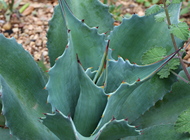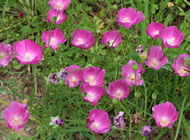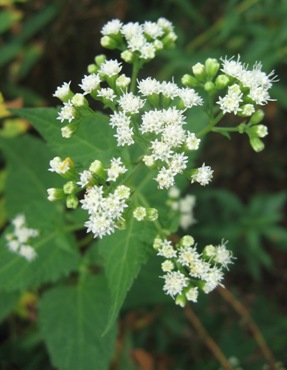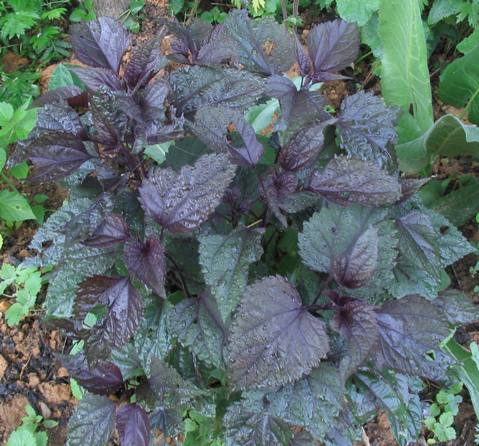 |
Eupatorium rugosum 'Chocolate' |
 |
|
|
| Synonym(s) |
Ageratina altissima |
| Common name |
white snakeroot |
| Family |
asteraceae |
| Life cycle |
perennial (Z4-8) |
| Flowers |
white (late summer-fall) |
| Size |
3-5' |
| Light |
sun-part shade |
| Cultural notes |
ordinary garden soil |
Purple foliage color (I wouldn't actually call it chocolate) is the main interest through most of the season - then in the late-season garden, the white flowerheads contrast nicely with the dark leaves. Late to show itself in spring - we've learned to make sure we know exactly where ours live. It's a thirsty plant, quick to wilt when rain stays away for a while. Consequently, given that we planted it where the waterhose seldom reaches, our plant seldom reaches its full potential.
|

| | Noticed this plain green representative of the species in the back yard island, some distance away from the 'Chocolate' specimen. Not sure if it's offspring from the purple one, but it's not much to look at in its green form. |
|
This plant used to grow in our garden, but it slipped away... About my plant portraits
Visitors to this page have left the following comments| Kate Macdonald | Aug 19, 2006 | Thank you! This is the best information I've been able to find on the Eupatorium Chocolate plant. |
| Patti | Oct 12, 2006 | Wonderful image and information, I love this website! |
| Ron Wlison | Sep 11, 2008 | Does this lose its leaves in the winter?
Yes - it's a herbaceous perennial that dies back to the ground every year, and resprouts from its roots. |
| Valerie Eninsche | Sep 28, 2008 | I just planted this plant this spring in a very dry shady spot next to my house, between a stand of weedy trees and my neighbor's place. It is still small but it never has appeared wilted in our midwestern dry summer. Maybe if your plant was in a shadier spot, it would be less stressed.
I've had the weedy green variety pop up and thrive in various garden areas, including quite sunny ones - but the 'Chocolate' cultivar seems to be much less tolerant of dry conditions (ours is planted in a partly shaded spot). |
| Elisa | Oct 16, 2008 | This is a great addition to my garden! I picked it up on a whim at the garden store because of the beautiful leaf color and it is just thriving! They were planted in my front garden (shady with sun in the morning only) in June and they just took off. They were about 14-15 inches tall when I planted then. Now, they are well above my waist at about 3 feet tall and very full. The white flower clusters started coming in about 3-4 weeks ago and the entire plant is covered with them. I watered it intently the first few weeks, then just left it to be the rest of the summer. I wish I had planted more (only two, side by side right now). |
| ACWinOH | Oct 18, 2008 | Just found your site today when looking for info on this plant. WOW! DH seldom comments on plants so when he does I make sure to include it and he loved this one at our nursery so I got it. It's quite young, only about 15" tall but a great root system but it's a stanger to me so I truly appreciate your site and the info provided! I'll be checking out rest of site as I'm an avid gardener when I'm able. Physical limitations make DH my favorite asset so it's wonderful when I can find a plant he admires. Thanks so much! - Carol |
| Pam Wiemers | Nov 02, 2008 | I've been reading about Eupatorium rugosum and have seen a couple of sites that say all parts of this plant are poisonous/highly toxic and 'may be fatal if eaten'. I have several and will be watching grandkids/dogs around them for sure. |
| moira Ormiston | May 30, 2009 | We love our Joe Pye and now we know the name of his cousin. Everyone admires it so now we can pass on the name. Both these plants can wilt a bit in our hot area of B.C.but it is a good reminder that they need a soak and they bounce back quickly. Ours is planted where it gets sun until mid afternoon. Seems happy as it grows to it's potential height and has a lovely shape. Water is the key. |
| Barbara | Jun 14, 2009 | This plant has taken off in my garden and is so happy it is quickly spreading ;
it does seem to wilt in the sun but that has not deterred it; have to pull
some of the "babies" to keep it from taking over.
|
| B-rad | Jul 17, 2009 | I hate this plant. It absolutely overran my whole perennial garden.. Beware. Almost impossible to eradicate once it gets going. |
| Kate Wilson | Sep 28, 2009 | I too love this beautiful plant - but it is a bit of a bully and is giving my lavender a very hard time. I want to leave it where it is - and cut it down to size. Should I do that now, in the autumn, or wait until the spring? Thanks,
Kate
The plain green variety has suddenly established itself as quite a pernicious weed in our garden - I'd be happy to be rid of it. Meanwhile, our chocolate version has expired - it was perhaps the mother of our current problem generation, but never seemed aggressive (or even vigorous) to me. You could certainly give it a good haircut now, and cut it down to the ground after freezing weather starts. I've not attempted to control its size by pruning in early summer, but Tracy DiSabato-Aust recommends doing so for E. purpureum in 'The Well-Tended Perennial Garden' - so it's worth a try. |
| aycee | Aug 07, 2010 | I have read elsewhere that this plant seeds extensively. Any information on that?
That would be correct - at least as far as its wild version is concerned. The green-leaved E. rugosa is pretty much a weed in our garden. These plants may or may not be offspring from our original purple-leaved plant (which has been absent from our garden for some years now). |
| andrea | Oct 06, 2010 | i have a newly planted shade garden including this eupatorium chocolate plant. i live in chicago so the weather has cooled down quite a bit to high 40s at night and 60-70 during the day. within the past couple of weeks, the leaves on the plant have dried up and the plant looks dead? is this normal fall/winter behavior or do is he not happy about something? what are my next steps? help!
Sounds like drought stress to me. |
| BC | Feb 10, 2011 | I wanted to order this plant to sell and was met with a tidal wave of groans from friends who've tried to eradicate seedlings for at least 5 years now. |
| victoria | Sep 07, 2011 | I got one of the end of last summer at a plant swap. The foliage was a nice dark winey color. Because it was so dry and the ground so hard I kept it in it's pot for about a month on our shady patio. By the time I planted it it had reverted to a plain green color. Thinking that it need sun to maintain the purple color I planted it in full sun. It's done real well there despite the hot dry weather this summer but it has stayed green all this time.
What will bring back the dark foliage? A shadier spot?
Victoria
I believe you're right, that full sun (with adequate moisture) is best for this plant. From what I've read, the plant will naturally turn to dark green by the end of the season, but should return in its burgundy hue the following spring. I don't know why yours didn't do that. |
| Zy | Sep 23, 2011 | When grown in persistently wet soil Chocolate will flop over when it gets taller than about 2'. And 3' height plants can flop in any condition soil when they get top-heavy with flowers. In our moderately rich but sandy soil it produces flowers equally well in full shade, full sun and every exposure in between. However, its mature height in full shade will be only about three quarters of that when growing elsewhere. Very invasive via seed production; especially in full sun. And yes Rob, those plain green volunteers are in fact Chocolate's offspring that have reverted to the general species, which is native here in NJ (zone 6). |
| Zy | Sep 23, 2011 | Long after you thought you eradicated this invasive plant, it may return due to two reasons:
1) It's now growing and producing seeds in a neighboring parcel of land.
2) Unlike commercial grass seed, its ungerminated seeds may stay viable in/on the ground for a number of years, depending on various conditions. |
| Penny | Sep 06, 2012 | I have the chocolate variety which I bought at an RHS show this year. I was not told that when buying that this plant is poisonous to cattle, horses, sheep and goats and to humans. It can also be transmitted to humans through the milk of cattle, goats etc. Although native to the USA it is also sold over here in the UK. Please be aware and make sure to deadhead after flowering to stop plants seeding into neighbouring gardens, farmland and pastures. If you want to propogate do it by division in the spring. |
| Peggy | Oct 02, 2014 | I have never seen a plant that attracted more insects -- the bees and wasps and even flies were all over it! :) |
| Lisa Tonetti | May 16, 2021 | BEWARE! This thing is a monster! I am spending the bulk of my spring digging up unwanted seedlings that are EVERYWHERE. I will try dead heading the fading blooms this season to see if it stops the spread. If this doesn't work it will completely eradicated. |
I welcome comments about my web pages; feel free to use the form below to
leave feedback about this particular page. For the benefit of other visitors
to these pages, I will list any relevant comments you leave, and if
appropriate, I will update my page to correct mis-information. Faced with an
ever-increasing onslaught of spam, I'm forced to discard any comments including
html markups. Please submit your comment as plain text. If you have a
comment about the website as a whole, please leave it in my
guestbook. If you
have a question that needs a personal response, please
e-mail me.
Last modified:
September 18, 2005
Contact me
|



